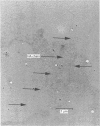Abstract
Hyaluronic acid (HA) and its synthesis were studied in intact Swiss 3T3 mouse fibroblasts and isolated membranes. HA chains in culture medium, attached to cells and in isolated membranes, were determined to possess average M(r) values of 5.2 x 10(6), 1.8 x 10(6) and 0.14 x 10(6) respectively. Log cells were determined to possess 680,000 HA molecules/cell, and to release 120,000 HA chains/h. The time required for intact cells to synthesize and release a complete HA chain was approximately 4 h, with elongation proceeding at a rate of 57 dimers/min. The amount of cell-associated HA of various cell populations correlated strongly with their rate of HA release into culture media and with the HA synthetase activity determined for their membranes. Prevention of protein synthesis with cycloheximide decreased the rate of HA synthesis of log cells and HA synthetase activity of isolated membranes by 50% within 2-3 h. Because of the similarity between the biological lifetime of HA synthetase and the time required to synthesize a HA chain, we propose a model where each synthetase makes only one HA chain; after synthesis of a complete HA chain, HA synthetase activity is terminated as its HA chain is released from the cell.
Full text
PDF







Images in this article
Selected References
These references are in PubMed. This may not be the complete list of references from this article.
- Bansal M. K., Mason R. M. Evidence for rapid metabolic turnover of hyaluronate synthetase in Swarm rat chondrosarcoma chondrocytes. Biochem J. 1986 Jun 1;236(2):515–519. doi: 10.1042/bj2360515. [DOI] [PMC free article] [PubMed] [Google Scholar]
- Bradford M. M. A rapid and sensitive method for the quantitation of microgram quantities of protein utilizing the principle of protein-dye binding. Anal Biochem. 1976 May 7;72:248–254. doi: 10.1016/0003-2697(76)90527-3. [DOI] [PubMed] [Google Scholar]
- Goldenberg G. J., Stein W. D. Increase in the affinity of the uridine phosphorylation system for ATP after serum or insulin activation of 3T3 fibroblasts. J Supramol Struct. 1978;9(4):489–496. doi: 10.1002/jss.400090404. [DOI] [PubMed] [Google Scholar]
- Hadler N. M., Napier M. A. Structure of hyaluronic acid in synovial fluid and its influence on the movement of solutes. Semin Arthritis Rheum. 1977 Nov;7(2):141–152. doi: 10.1016/0049-0172(77)90020-8. [DOI] [PubMed] [Google Scholar]
- Heider K. H., Hofmann M., Hors E., van den Berg F., Ponta H., Herrlich P., Pals S. T. A human homologue of the rat metastasis-associated variant of CD44 is expressed in colorectal carcinomas and adenomatous polyps. J Cell Biol. 1993 Jan;120(1):227–233. doi: 10.1083/jcb.120.1.227. [DOI] [PMC free article] [PubMed] [Google Scholar]
- Knudson C. B., Knudson W. Similar epithelial-stromal interactions in the regulation of hyaluronate production during limb morphogenesis and tumor invasion. Cancer Lett. 1990 Jul 16;52(2):113–122. doi: 10.1016/0304-3835(90)90253-t. [DOI] [PubMed] [Google Scholar]
- Knudson W., Biswas C., Toole B. P. Interactions between human tumor cells and fibroblasts stimulate hyaluronate synthesis. Proc Natl Acad Sci U S A. 1984 Nov;81(21):6767–6771. doi: 10.1073/pnas.81.21.6767. [DOI] [PMC free article] [PubMed] [Google Scholar]
- Laurent T. C. Biochemistry of hyaluronan. Acta Otolaryngol Suppl. 1987;442:7–24. doi: 10.3109/00016488709102833. [DOI] [PubMed] [Google Scholar]
- Laurent U. B., Tengblad A. Determination of hyaluronate in biological samples by a specific radioassay technique. Anal Biochem. 1980 Dec;109(2):386–394. doi: 10.1016/0003-2697(80)90665-x. [DOI] [PubMed] [Google Scholar]
- Lindahl U., Hök M. Glycosaminoglycans and their binding to biological macromolecules. Annu Rev Biochem. 1978;47:385–417. doi: 10.1146/annurev.bi.47.070178.002125. [DOI] [PubMed] [Google Scholar]
- Mausolf A., Jungmann J., Robenek H., Prehm P. Shedding of hyaluronate synthase from streptococci. Biochem J. 1990 Apr 1;267(1):191–196. doi: 10.1042/bj2670191. [DOI] [PMC free article] [PubMed] [Google Scholar]
- Mian N. Analysis of cell-growth-phase-related variations in hyaluronate synthase activity of isolated plasma-membrane fractions of cultured human skin fibroblasts. Biochem J. 1986 Jul 15;237(2):333–342. doi: 10.1042/bj2370333. [DOI] [PMC free article] [PubMed] [Google Scholar]
- Ng K. F., Schwartz N. B. Solubilization and partial purification of hyaluronate synthetase from oligodendroglioma cells. J Biol Chem. 1989 Jul 15;264(20):11776–11783. [PubMed] [Google Scholar]
- Philipson L. H., Schwartz N. B. Subcellular localization of hyaluronate synthetase in oligodendroglioma cells. J Biol Chem. 1984 Apr 25;259(8):5017–5023. [PubMed] [Google Scholar]
- Philipson L. H., Westley J., Schwartz N. B. Effect of hyaluronidase treatment of intact cells on hyaluronate synthetase activity. Biochemistry. 1985 Dec 31;24(27):7899–7906. doi: 10.1021/bi00348a008. [DOI] [PubMed] [Google Scholar]
- Prehm P. Hyaluronate is synthesized at plasma membranes. Biochem J. 1984 Jun 1;220(2):597–600. doi: 10.1042/bj2200597. [DOI] [PMC free article] [PubMed] [Google Scholar]
- Scott J. E., Cummings C., Brass A., Chen Y. Secondary and tertiary structures of hyaluronan in aqueous solution, investigated by rotary shadowing-electron microscopy and computer simulation. Hyaluronan is a very efficient network-forming polymer. Biochem J. 1991 Mar 15;274(Pt 3):699–705. doi: 10.1042/bj2740699. [DOI] [PMC free article] [PubMed] [Google Scholar]
- Tengblad A. Quantitative analysis of hyaluronate in nanogram amounts. Biochem J. 1980 Jan 1;185(1):101–105. doi: 10.1042/bj1850101. [DOI] [PMC free article] [PubMed] [Google Scholar]
- Toole B. P. Developmental role of hyaluronate. Connect Tissue Res. 1982;10(1):93–100. doi: 10.3109/03008208209034409. [DOI] [PubMed] [Google Scholar]



